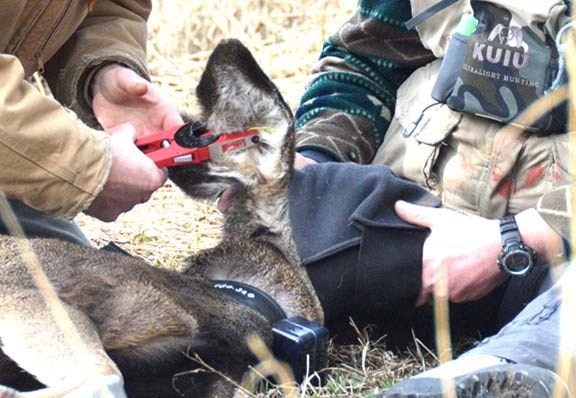The capture process has wrapped up for a regional urban deer translation project, as 60 mule deer have been relocated from four communities to winter range areas.
The project, part of a highly anticipated study being undertaken by Vast Resource Solutions and contributing partners, has been attaching radio collars and translocating urban deer in Cranbrook, Kimberley, Invermere and Elkford to winter range areas.
“We’ve moved all the deer we’re going to move and now we are monitoring the collar data for how the deer fare, where they’re moving, and their survivorship,” said Ian Adams, the senior wildlife biologist with Vast Resource Solutions. “For the most part, the field component for the work is done.”
Adams cautioned that the project is a science-based trial and not intended to be a tool for managing urban deer populations—yet.
“It’s certainly a very complex issue and if this is successful, it allows a non-lethal alternative to reducing numbers, but I don’t think anybody should be suggesting that this is going to solve our urban deer questions,” he added.
Moving 60 urban deer was within the original target, Adams said.
“We had hoped to get 10-15 animals per community. Our objective was to learn from the process, how the process works, not necessarily to move as many deer as possible,” Adams said. “So we were successful in that way. We deployed all our radio collars that we had, 28 radio collars went out. There was one cougar mortality from a Kimberley deer, that collar went out again on a deer from Elkford.”
Over the last few months, urban deer were captured using non-lethal traps in urban communities, sedated and transported out to regional wilderness ranges. Of those 60 deer that were translocated, 29 were fitted with radio collars that will send a location to a satellite every 13 hours over the next year and a half—or until the radio collar batteries run out.
If a collar doesn’t move for eight hours, an alert is sent out and Adams assumes the animal has died, which will prompt a trip to the exact location of the collar to determine the cause of the deer’s mortality.
The collar data will provide valuable information to Adams and provincial wildlife biologists to see if migration patterns of mule deer that have been habituated in urban communities follow that of non-urban mule deer.
“Perhaps the next biggest question is whether the translocated mule deer migrate upslope later in the spring,” Adams asked. “Certainly some urban deer stay in town year round, others likely do migrate. It will be interesting to see what the deer we’ve moved do.”
Within the context of using translocation as an urban deer management tool, there are numerous questions remaining.
The translocation project had a number of partners, including significant staff time from provincial wildlife biologists from the Ministry of Forests, Lands and Natural Resource Operations. Volunteers and in-kind assistance also included members of local rod and gun clubs, a ungulate anesthesiologist with the University of Calgary and the municipalities themselves, which kicked in some funding.
